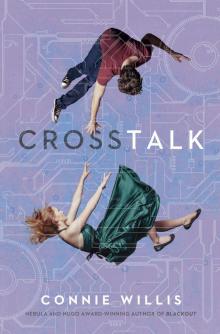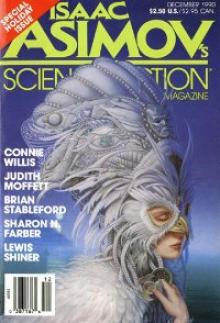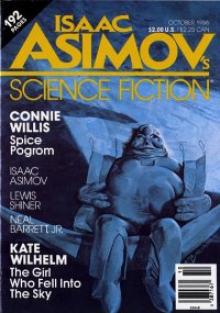- Home
- Connie Willis
Bellwether Page 4
Bellwether Read online
Page 4
“That package clearly said ‘perishable’ on it,” she said, pressing her palms against mine. “You should have delivered it to me immediately.”
“You weren’t there.”
“Then you should have found out where I was.”
“Two,” Management said.
“That package contained valuable cultures. They could have spoiled.”
She seemed to have lost sight of an important point here. “Flip was the one who was supposed to have delivered it to you.”
“Then what was it doing in your office?”
“Three,” Management said.
“Next time I’d appreciate it if you’d leave a message on my e-mail,” she said. “Well? Aren’t you going to tell me three things you like about me? It’s your turn.”
I like it that you work in Bio and that it’s clear on the other end of the complex, I thought. “I like your suit,” I said, “even though shoulder pads are terribly passé. And so is red. Too threatening. Feminine is what’s in.”
“Don’t you feel better about yourself?” Management said, beaming. “Don’t you feel closer to your fellow worker?”
Too close, in fact. I beat a hasty retreat back to my table and Gina. “Where did you go?” I demanded.
“To the bathroom,” she said. “Meeting Survival Rule Number One. Always be out going to the bathroom during sensitivity exercises.”
“Before we go any further,” Management said, and I braced myself to make a break for the bathroom in case of another sensitivity exercise, but Management was moving right along to the increased paperwork portion of our program, which turned out to be procurement forms.
“We’ve had some complaints about Supply,” Management said, “so we’ve instituted a new policy that will increase efficiency in that department. Instead of the old departmental supply forms, you’ll use a new interdepartmental form. We’ve also restructured the funding allocation procedure. One of the most revolutionary aspects of GRIM is the way it streamlines funding. All applications for project funding will be handled by a central Allocations Review Committee, including projects which were previously approved. All forms are due Monday the twenty-third. All applications must be filed on the new simplified funding allocation application forms.”
Which, if the stack of papers Flip was holding in her duct-taped arms as she passed among the crowd was any indication, were longer than the old funding application forms, and they were thirty-two pages.
“While the interdepartmental assistant’s distributing the forms, I want to hear your input. What else can we do to make HiTek a better place?”
Eliminate staff meetings, I thought, but didn’t say it. I may not be as well versed as Gina is in Meeting Survival, but I do know enough not to raise my hand. All it does is get you put on a committee.
Apparently everybody else knew it, too.
“Staff Input is the cornerstone of HiTek,” he said.
Still nothing.
“Anybody?” Management said, looking GRIM. He brightened. “Ah, at last, someone who’s not afraid to stand out in a crowd.”
Everybody turned to look.
It was Flip. “The interdepartmental assistant has way too many duties,” she said, flipping her hank of hair.
“You see,” Management said, pointing at her. “That’s the kind of problem-solving attitude that GRIM is all about. What solution do you suggest?”
“A different job title,” Flip said. “And an assistant.”
I looked across the room at Dr. O’Reilly. He had his head in his hands.
“Okay. Other ideas?”
Forty hands shot up. I looked at the waving hands and thought about the Pied Piper and his rats. And about hair-bobbing. Most hair fads are a clear case of follow-the-Piper. Bo Derek, Dorothy Hamill, Jackie Kennedy, had all started hairstyle fads, and they were by no means the first. Madame de Pompadour had been responsible for those enormous powdered wigs with sailing ships and famous artillery battles in them, and Veronica Lake for millions of American women being unable to see out of one eye.
So it was logical that hair-bobbing had been started by somebody, only who? Isadora Duncan had bobbed her hair in the early 1900s, and several suffragettes had bobbed theirs (and put on men’s clothes) long before mat, but neither had attracted any followers to speak of.
The suffragettes were obviously ahead of their time (and rather fearsomely formidable). Isadora, who leaped around the stage in skimpy chiffon tunics and bare feet, was too weird.
The obvious person was the ballroom dancer Irene Castle. She and her husband, Vernon (more miserable little boys), had set several dancing trends: the one-step, the hesitation waltz, the tango, the turkey trot, and, of course, the Castle Walk.
Irene was pretty, and almost everything she wore had become a fad, from white satin shoes to little Dutch caps. In 1913, at the height of their popularity, she’d had her hair cut short while she was in the hospital after an appendectomy, and she’d kept it short after she got better and had worn it with a wide band that clearly foreshadowed the flappers.
She was a known fashion-setter, and she’d definitely had followers. But if she was the source, why had it taken so long to catch on? When Bo Derek’s corn-rowed hair hit movie screens in 1979, it was only a week before corn-rowed women started showing up everywhere. If Irene was the source, why hadn’t hair-bobbing become a fad in 1913? Why had it waited for nine years and a world war to become a fad?
Maybe the movies were the key. No, Mary Pickford hadn’t cut off her long curls until 1928. Had Irene and Vernon Castle done a silent film in, say, 1921?
Management was still calling on waving hands.
“I think we should have an espresso cart in the building,” Dr. Applegate said.
“I think we should have a workout room,” Elaine said.
“And some more stairs.”
This could go on all day, and I wanted to check and see what movies had come out in 1922. I stood up, as unobtrusively as possible, snatched a form from Flip, who had skipped our table, and ducked out the back, leafing through the form to see how long it was.
Wonder of wonders, it was actually shorter than the original. Only twenty-two pages. And the type was only slightly smaller than—I crashed into someone and looked up.
It was Dr. O’Reilly, who must have been doing the same thing. “Sorry,” he said. “I was thinking about this funding reapplication thing.” He raised both hands, still holding the funding form in the right one, and faced his palms out. “Tell your partner three things you don’t like about Management.”
“Can it be more than three?” I said. “I suppose this means you won’t get your macaques right away, Dr. O’Reilly.”
“Call me Bennett,” he said. “Flip’s the only one with a title. I was supposed to get them this week. Now I’ll have to wait till the twentieth. How about you? Does this affect your Hula Hoop project?”
“Hair-bobbing,” I said. “The only effect is that I won’t have any time to work on it because I’ll be filling out this stupid form. I wish Management would find something to think about besides making up new forms.”
“Shh,” someone said fiercely from the door.
We moved farther down the hall, out of range.
“Paperwork is the cornerstone of Management,” Bennett whispered. “They think reducing everything to forms is the key to scientific discovery. Unfortunately science doesn’t work that way. Look at Newton. Look at Archimedes.”
“Management would never have approved the funding for an orchard,” I agreed, “or a bathtub.”
“Or a river,” Bennett said. “Which is why we lost our chaos theory funding and I had to come to work for GRIM.”
“What were you working on?” I asked.
“The Loue. It’s a river in France. It has its source in a grotto, which means it’s a small, contained system with a comparatively limited number of variables. The systems scientists have tried to study before were huge—weather, the human body, rive
rs. They had thousands, even millions of variables, which made them impossible to predict, so we found …”
Up close his tie was even more nondescript than from a distance. It appeared to have some sort of pattern, though what exactly I couldn’t make out. Not paisley (which had been popular in 1988), or polka dots (1970). It wasn’t a nonpattern either.
“… and measured the air temperature, water temperature, dimensions of the grotto, makeup of the water, plant Ufe along the banks—” he said and stopped. “You’re probably busy and don’t have time to listen to all this.”
“That’s okay,” I said. “I’ve got to go back to my office, but I’ll walk you as far as the stairs.”
“Okay, well, so my idea was that by precisely measuring every factor in a chaotic system, I could isolate the causes of chaos.”
“Flip,” I said. “The cause of chaos.”
He laughed. “The other causes of chaos. I know talking about the causes of chaos sounds like a contradiction in terms, since chaotic systems are supposed to be systems where ordinary cause and effect break down. They’re nonlinear, which means there are so many factors, operating in such an interconnected way, that they’re impossible to predict.” Like fads, I thought.
“But there are laws governing them. We’ve mathematically defined some of them: entropy, interior instabilities, and iteration, which is—”
“The butterfly effect,” I said.
“Right. A tiny variable feeds back into the system and then the feedback feeds back, until it influences the system all out of proportion to its size.”
I nodded. “A butterfly flapping its wings in L.A. can cause a typhoon in Hong Kong. Or an all-staff meeting at HiTek.”
He looked delighted. “You know something about chaos?”
“Only from personal experience,” I said.
“Yeah,” he said, “it does seem to be the order of the day around here. Well, so, anyway, my project was to calculate the effects of iteration and entropy and see if they accounted for chaos or if there was another factor involved.”
“Was there?”
He looked thoughtful. “Chaos theorists think the Heisenberg uncertainty principle means that chaotic systems are inherently unpredictable. Verhoest believes that prediction is possible, but he’s proposed there’s another force driving chaos, an X factor that’s influencing its behavior.”
“Moths,” I said.
“What?”
“Or locusts. Something other than butterflies.”
“Oh. Right. But he’s wrong. My theory is that iteration can account for everything that goes on in a chaotic system, once all the factors are known and properly measured. I never got the chance to find out. We were only able to do two runs before I got my funding cut. They didn’t show an increase in predictability, which means either I was wrong or I didn’t have all the variables.” He stopped, his hand on a door handle, and I realized we were standing outside his door. I had apparently walked him all the way down to Bio.
“Well,” I said, wishing I had more time to analyze his tie, “I guess I’d better get back to work. I’ve got to brace myself for Flip’s new assistant. And fill out my funding allocation form.” I looked at it ruefully. “At least it’s short.”
He peered blankly at me through his thick glasses.
“Only twenty-two pages,” I said, holding it up.
“The funding forms aren’t printed up yet,” he said. “We’re supposed to get them tomorrow.” He pointed at the form I was holding. “That’s the new simplified supply procurement form. For ordering paper clips.”
Mankind, of course,
always has been and always will be, under the yoke of the
butterflies in the matter of social rites,
dress, entertainment, and the expenditure which these things involve.
hugh shetfield, the sovereignty of society, 1909
miniature golf (1927—31)—–Recreation fad of small golf courses with eighteen very short holes complicated by windmills, waterfalls, and tiny sand traps. Its popularity was easily explainable. It was a cheap place to take a Depression date, had a low skill threshold with multiple achievement levels, and let you pretend for a couple of hours that you were part of the refined country-club set. Over forty thousand courses sprang up across the country, and at its height it was so popular it was even a threat to the movies, and the studios forbade their actors to be seen playing miniature golf. Died from overexposure.
The source of the Colorado River doesn’t look like one either. It’s in a glacier field up in the Green River Mountains, and what it looks like is tundra and snow and rock.
But even in deepest winter there’s some melting, a drop here, a trickle there, a little film of water forming at the grubby edges of the glacier and spilling over onto the frozen ground. Falling and freezing, collecting, converging, so slowly you can’t see it.
Scientific research is like that, too. “Eureka!”s like the one Archimedes had when he stepped in a bathtub and suddenly realized the answer to the problem of testing metals’ density are few and far between, and mostly it’s just trying and failing and trying something else, feeding in data and eliminating variables and staring at the results, trying to figure out where you went wrong.
Take Arno Penzias and Robert Wilson. Their goal was to measure the absolute intensity of radio signals from space, but first they had to get rid of the background noise in their detector.
They moved their detector to the country to get rid of city noise, radar stations, and atmospheric noise, which helped, but there was still background noise.
They tried to think what might be causing it. Birds? They went up on the roof and looked at the horn-shaped antenna. Sure enough, pigeons were nesting inside it, leaving droppings that might be causing the problem.
They evicted the pigeons, cleaned the antenna, and sealed every possible joint and crack (probably with duct tape). There was still background noise.
All right. So what else could it be? Streams of electrons from nuclear testing? If it was, the noise should be diminishing, since atomic tests had been banned in 1963. They ran dozens of tests on the intensity to see if it was. It wasn’t.
And it seemed to be the same no matter which part of the heavens were overhead, which made no sense at all.
They tested and retested, taped and retaped, scraped off pigeon droppings, and despaired of ever getting to the point where they could perform their experiment on radio signal intensity for nearly five years before they realized what they had wasn’t background noise at all. It was microwaves, the resounding echo of the Big Bang.
Friday Flip brought the new funding application. It was sixty-eight pages long and poorly stapled. Three pages fell out of it as Flip slouched in the door and two more as she handed it to me. “Thank you, Flip,” I said, and smiled at her.
The night before I had read the last two thirds of Pippa Passes, during which Pippa had talked two murderously adulterous lovers into killing themselves, convinced a deceived young student to choose love over revenge, and reformed assorted ne’er-do-wells. And all just by chirping, “The year’s at the spring,/And day’s at the morn.” Think what she could have accomplished if she’d had a library card.
“You can change the world,” Browning was clearly saying. “By being perky and signaling before turning left, one person can have a positive effect on society,” and it was obvious from “The Pied Piper” that he understood how trends worked.
I hadn’t noticed any of these effects, but then neither had Pippa, who had presumably gone back to work at the silk factory the next day without any notion of all the good she’d done. I could see her at the staff meeting Management had called to introduce their new management system, PESTO. Right after the sensitivity exercise her coworker would lean over and whisper, “So, Pippa, what did you do on your day off?” and Pippa would shrug and say, “Nothing much. You know, hung out.”
So I might be having more of an effect on literacy and left-turn signaling
than I’d realized, and, by being pleasant and polite, could stop the downward trend to rudeness.
Of course, Browning had never met Flip. But it was worth a try, and I had the comfort of knowing I couldn’t possibly make things worse.
So, even though Flip had made no effort to pick up the spilled pages and was, in fact, standing on one of them, I smiled at her and said, “How are you this morning?”
“Oh, just great” she said sarcastically. “Perfectly fine.” She flopped down onto the hair-bobbing clippings on my lab table. “You will not believe what they expect me to do now!”
A little work? I thought uncharitably, and then remembered I was supposed to be following in Pippa’s footsteps. “Who’s they?” I said, bending to pick up the spilled pages.
“Management” she said, rolling her eyes. She was wearing a pair of neon-yellow tights, a tie-dyed T-shirt, and a very peculiar down vest. It was short and bunched oddly around the neck and armpits. “You know how I’m supposed to get a new job title and an assistant?”
“Yes,” I said, continuing to smile. “Did you? Get a new job title?”
“Ye-es,” she said. “I’m the interdepartmental communications liaison. But for my assistant, they expect me to be on a search committee. After work.”
Along the bottom of the vest there was a row of snaps, a style I had never seen before. She’s wearing it upside down, I thought.
“The whole point was I was overworked. That’s why I have to have an assistant, isn’t it? Hello?”
Wearing clothing some other way than was intended is an ever-popular variety of fad—untied shoelaces, backward baseball caps, ties for belts, slips for dresses—and one that can’t be put down to merchandising because it doesn’t cost anything. It’s not new, either. High school girls in 1955 took to wearing their cardigan sweaters backward, and their mothers had worn unbuckled galoshes with short skirts and raccoon coats in the 1920s. The metal buckles had jangled and flapped, which is how the name flapper came about. Or, since there doesn’t seem to be agreement on the source of anything where fads are concerned, they were named for the chicken like flapping of their arms when they did the Charleston. But the Charleston didn’t hit till 1923, and the word flapper had been used as early as 1920.

 Passage
Passage Bellwether
Bellwether Blackout
Blackout Doomsday Book
Doomsday Book A Lot Like Christmas: Stories
A Lot Like Christmas: Stories Water Witch
Water Witch To Say Nothing of the Dog
To Say Nothing of the Dog Fire Watch
Fire Watch The Winds of Marble Arch and Other Stories
The Winds of Marble Arch and Other Stories Uncharted Territory
Uncharted Territory All Clear
All Clear Crosstalk
Crosstalk Lincoln's Dreams
Lincoln's Dreams Miracle and Other Christmas Stories
Miracle and Other Christmas Stories Time is the Fire
Time is the Fire Blackout ac-1
Blackout ac-1 Dooms Day Book
Dooms Day Book Jack
Jack The Doomsday Book
The Doomsday Book Terra Incognita
Terra Incognita The Best of Connie Willis
The Best of Connie Willis Cibola
Cibola Schwarzschild Radius
Schwarzschild Radius Even the Queen
Even the Queen The Last of the Winnebagos
The Last of the Winnebagos Spice Pogrom
Spice Pogrom Oxford Time Travel 1 - Blackout
Oxford Time Travel 1 - Blackout At The Rialto
At The Rialto A Lot Like Christmas
A Lot Like Christmas